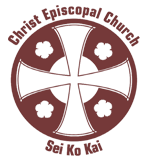Looking at the Eucharist
 There are times when the preacher looks at the lessons in the lectionary, and then looks at them again, and then for a third time, and says out loud, “What am I going to preach on??” This would be one of those Sundays.
There are times when the preacher looks at the lessons in the lectionary, and then looks at them again, and then for a third time, and says out loud, “What am I going to preach on??” This would be one of those Sundays.
So I want to take a few minutes to explain what a lectionary is, why we use it, how we got what we have, and so on. Then I will come back to the readings.
A lectionary is a list of readings. Lectio is the Latin word for read, the lections are the readings, a lector is a reader of lessons. If you will pull out the BCP and look on page 888, you will find the explanation of how to use the lectionary. Basically, it makes sections of the Bible, so that if you attended church every week for three years running, you would have heard almost all of the entire Bible. There are certain pieces missing. There are two lectionaries in the BCP, the first one that starts on p. 889 is for the Sunday services, and the second one that starts on page 936 is the one for daily services. Daily services? Yes, turn to page 75, where you will find the Morning Prayer service – which used to be the normal Sunday service, before the revision of the BCP, and p. 103 for Noonday Prayer, and p. 115 for Evening Prayer, and p. 127 for Compline or night prayer. Finally, turn to p. 137, Daily Devotions for Individuals and Families. If you used any of these services, you could use either lectionary for the psalms and readings.
But why do we use a lectionary at all? The idea of having a lectionary comes to us from Judaism, where each Sabbath, a section from the scroll was read. If we understand how a scroll works, it helps explain this. When you have a book, it is easy to open to any place in the book. When you have a scroll, it is not easy to open to any place – you need to read it in order to get through the whole thing. So each service, the scroll is brought out, laid down, the next section is unrolled, read, and then the other side is rolled to it to be ready to read the next section. A “page” is the width of a skin, originally, then papyrus stitched together. After reading through the whole scroll, there is a special service where the congregation stands around the entire room, and the scroll is unrolled, and everyone holds up their part, and then it is rolled back up to start over again. This happens once a year.
So that is the historical background. What I think is a good reason to continue using the lectionary is that we tend to like comfort, we always pick pleasure over pain. If we have the option of choosing what is known, we will usually – not always – but usually, we will choose familiar things over unfamiliar. Don’t you like singing hymns you know better than ones you don’t know? It’s normal. But we miss things, sometimes important things, when we go with the familiar too often. Having a lectionary makes sure that we at least see the whole Bible, even if we skip over certain things. So, for instance, the Gospel speaks about Jesus being bread – again! This is the third week, and we have already talked about Jesus and bread, and rice, and what this meant to them, and what it might mean to us. What I understand by this is that for John’s audience, this was a very big deal. OK, fine, but what’s a preacher to do?
I am very lucky to be living with a priest who also has to put together a sermon for each Sunday, so we usually talk about what we are preaching about, and she mentioned the repetition of bread and flesh in John, and reminded me that they really did believe that “you are what you eat.” Whoa! That’s a very interesting spin on the whole “eat my flesh and drink my blood” isn’t it? But isn’t that exactly what we believe, or at least what we say we believe?
So back to the education part again. When you hear the words, “eat my flesh and drink my blood” what do you think of? The Eucharist, right? And what do we believe happens in the Eucharist? In the Roman Catholic Church, they officially believe that the bread and wine actually turn into the flesh and blood of Jesus. In the Methodist Church that I grew up in, and most other Protestant churches, they focus on the words of Jesus at the Last Supper, where he said: “do this in memory of me” and they say it is a “memorial” and nothing more. In the Episcopal Church, we believe that Jesus is “present” in the Eucharist. What does that mean? How does that happen? Here’s the really important answer: we don’t tell you. What we will tell you is that we believe Jesus is present in the Eucharist. We will also tell you what the historical answers to that question have been. There is the Orthodox answer, which I really like, that says that when we celebrate the Eucharist here, that we participate in the heavenly banquet that is going on, it’s like we get in sync with heaven when we engage in the “practice” of breaking bread, drinking wine, and giving thanks to God. More about practice later. There are the Roman Catholic and Protestant answers, which I said before. I told one Protestant friend that we believe Jesus is present in the Eucharist, and she said, well yes, whenever two or three are gathered in his Name, he is present. So what happens? You get to decide what “happens” and what it “means.” What is important, as far as the official Episcopal Church will say, is that we engage in the practice of the Eucharist, making Jesus present to us.
But let us return to the notion, “you are what you eat.” Ancient warriors sometimes ate the hearts of their enemies, believing that they were adding to their strength. What do you think? If we “eat Jesus” do we become Jesus? In a metaphorical manner of speaking, I think the answer is yes. Think about it – if you eat poison, you get poisoned. If you eat healthy, you get healthier. What we take into ourselves does make a difference. So engaging in the practice of Eucharist helps us show forth Jesus.
There are four parts to our Eucharist service. We listen to the teachings, we pray, we eat and drink together, we give thanks. They are all important. In the early church, the people who were interested but who had not yet been baptized were allowed to come to the teaching, but nothing else. They were not allowed to be part of the prayers, because the early church knew how powerful prayer was. They were not allowed to be part of the eating and drinking together, and they were not there to give thanks.
In the letter to the Ephesians, Paul says, “Give thanks to God at all times and for every thing.” My Quaker friend said that we need to make it a practice to have “mini-Eucharist” every time we eat and drink, not just this special meal here. What would it be like if, at every meal, we remembered Jesus saying “this is my body, this is my blood” and if we ate and drank as though Jesus were sitting at table with us – what would that be like? And how would we be, what would we be like, if we received the spirit of Jesus every time we ate food, and gave thanks?
I can only imagine my astonishment, my amazement, if I was sitting there at one of the tables in the cafe area of the plaza, waiting for someone, and Jesus walked up with a tray of food, and sat down, looked at me and said “here, eat this – this is my body, this is my blood, remember me and give thanks.” I expect my mouth would fall open, and I think I would cry. Then I hear his voice saying, “every time you eat and drink, remember me, and give thanks to God.”
When we move from any negative emotion into gratitude, this giving thanks in all things and at all times, things change, they change all the way down to the cellular level in our bodies, and they change in the air around us. It is not a trivial thing we can do, it is very powerful. As followers of the Way of Jesus, I think we are called to become more and more like the one we follow. One of the practices to do that is to give thanks, as Paul says, at all times and for every thing. Another practice is to eat and drink together, remembering the presence of Jesus, and giving thanks to God for that.
As you go through your week, see what happens if you imagine Jesus is at table with you, sharing your rice and chicken, sharing tea with you. What would be different? Does Jesus know how to use hashi?
So a final story, perhaps I have told it before. I made friends with a gay deaf man named Dale who had AIDS. I was learning sign language and he was very patient with me. I visited him frequently, and then the time came that he was dying, so I came every day. One day I walked in, and he was signing away. I looked around, there was no one in the room. Oh hi, he signed to me. Who are you talking to? I asked. The angels, he said. Did you know that they know how to sign? He was so happy! I didn’t know, I told him, but I’m glad they do.
The next day, I came in, and again, he was signing like mad. Clearly, I was interrupting an important conversation. We talked a little, but it was obvious he really wanted to talk to them. The third day, it was like I was not really there. The angels were very present to him, and he was having a ball. That night, he went with them. Yes, Jesus uses o-hashi.
Our Readings Today
- [thkBC height=”600″ width=”900″ anchortext=”Reading One Citation” title=”Reading One Citation” url=”https://www.bible.com” type=”iframe”]
- [thkBC height=”600″ width=”900″ anchortext=”Reading Two Citation” title=”Reading Two Citation” url=”https://www.bible.com” type=”iframe”]


